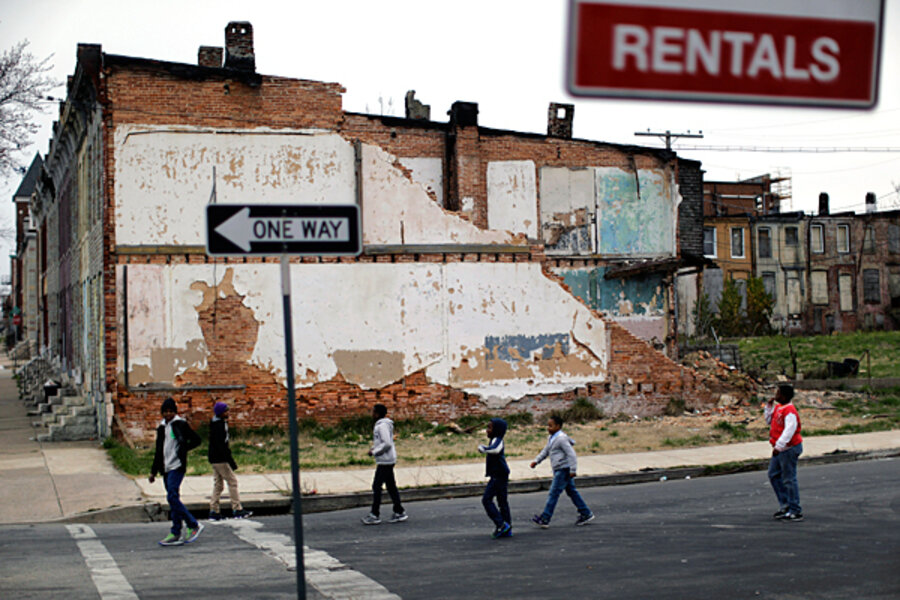US poverty rate steady at 15 percent, but 'lower class' is booming
Loading...
Poorer Americans were no better off – and no worse off – in 2012 than in 2011, compared with their richer neighbors, the Census Bureau reported Tuesday. The news may indicate that struggling workers and families whose fortunes have plummeted since the Great Recession have at last hit a financial plateau.
But if the slide into poverty has finally stalled out, it appears to have left its mark on the psyches of many American workers. The share of those who identify themselves as "lower class" – at 8.4 percent – now stands at its highest level in four decades, according to separate data released this week from the long-running General Social Survey (GSS). Just as surprising, the share of college graduates who describe themselves as lower class has jumped from 2.6 percent in 2002 to 5.8 percent in 2012.
Sociologists say the true percentage of the lower class may be as high as 20 percent, and primarily includes people who hold low-rung service jobs or are chronically unemployed.
But they are puzzled as to why more Americans are calling themselves "lower class," a derogatory term that until recently was used so seldom that economists routinely lumped it in with the more respectable "working class." The jump in lower class self-identification is “extraordinary,” Dennis Gilbert of Hamilton College in New York, who studies class structures, writes in an e-mail.
One possibility is that they feel stuck. According to the GSS, only 55 percent of Americans these days believe things will get better for themselves and their kids – a rather paltry number for a country built on the notion that everyone has an equal chance to get ahead.
"It's not surprising if the American worker is thinking, 'I'm working harder than I've ever worked, yet I'm being paid less – and I'm working two or maybe three jobs,' " Lola Smallwood Cuevas, project director of the Los Angeles Black Worker Center, told Los Angeles Times writer Emily Alpert this week. "It creates a feeling that you're trapped."
Indeed, the Census Bureau report released Tuesday shows that the Great Recession and its aftermath have been hardest on the poorest one-fifth of Americans. Their mean income fell 3.3 percent, while the mean income for the top one-fifth of earners dropped 0.5 percent. That means inequality has increased since the recession, and that income losses among the poorer is primarily responsible for the wider gap.
Class consciousness, moreover, might have been at a high when University of Chicago researchers conducted their General Social Survey. It was an election year, and "class warfare" was a theme of the presidential contest – with GOP candidate Mitt Romney saying, famously, that “47 percent” of Americans saw themselves as victims in need of handouts, and with President Obama defining the election as “a make-or-break moment for the middle class.”
“People perceive that [class advancement] has become a zero-sum game, and that’s corrosive,” says Philip Cohen, a sociologist at the University of Maryland, in College Park. “The overall economic uncertainty exacerbates some of the problems we’re having. Look at this intensive parenting mania … that’s partly because we see inequality widening and we don’t want our kids to end up on the wrong side of that line.”
Those most likely to describe themselves as lower class are high school dropouts, blacks, the unemployed, and single parents.
Overall, the poverty rate held steady 15 percent in 2012, the same as the year before, and roughly the same as other tough economic eras such as the early 1980s and early 1990s, census data show. The median income last year was $51,017 – about the same as in 2011. But the share of people who qualify as middle class has been steadily shrinking for a decade, and since 2007, when the US economy began to contract, median income remains down 8.3 percent.
But there are hopeful statistics to report. The number of Americans without health insurance dropped slightly in 2012, as did the percentage of single mothers in poverty – possible signals that the fortunes of some Americans are no longer sinking.
“Even though unemployment and long-term unemployment continues, we’re not seeing a deepening in poverty outcomes, and that’s good,” says Mr. Cohen.
For all its constitutional egalitarianism, America is class conscious and puts great stock in the merits of breaking through class ceilings through hard work.
That’s another reason the rising self-identification with the “lower class” is notable. “Working class” has always been the admirable way to frame a life of self-sufficiency and grit, if not great riches. The question now is whether people who see themselves as "lower class" accept the permanence of piecemeal or nonexistent work – and have waved goodbye to the middle class.
“If these trends continue, and most evidence suggests they will, one of the central ironies of the Obama years will be that a Democratic administration committed to pushing back against the unjust distribution of resources and to the promotion of morally cohesive communities will in fact have overseen an eight-year period of social disintegration, inequality and rising self-preoccupation,” New York Times columnist Thomas Edsall wrote in June.
Other commentators say surveys of American workers suggest that many are waiting for political redemption and new leadership to help them replace creeping resignation with a sense of opportunity.
“A besieged middle class is increasingly aware that the rules are rigged against them,” writes Robert Borosage in a recent article for Slate. “They are increasingly skeptical of politicians and parties, and believe – not incorrectly – that Washington is largely bought and sold. But they are looking for champions.”








